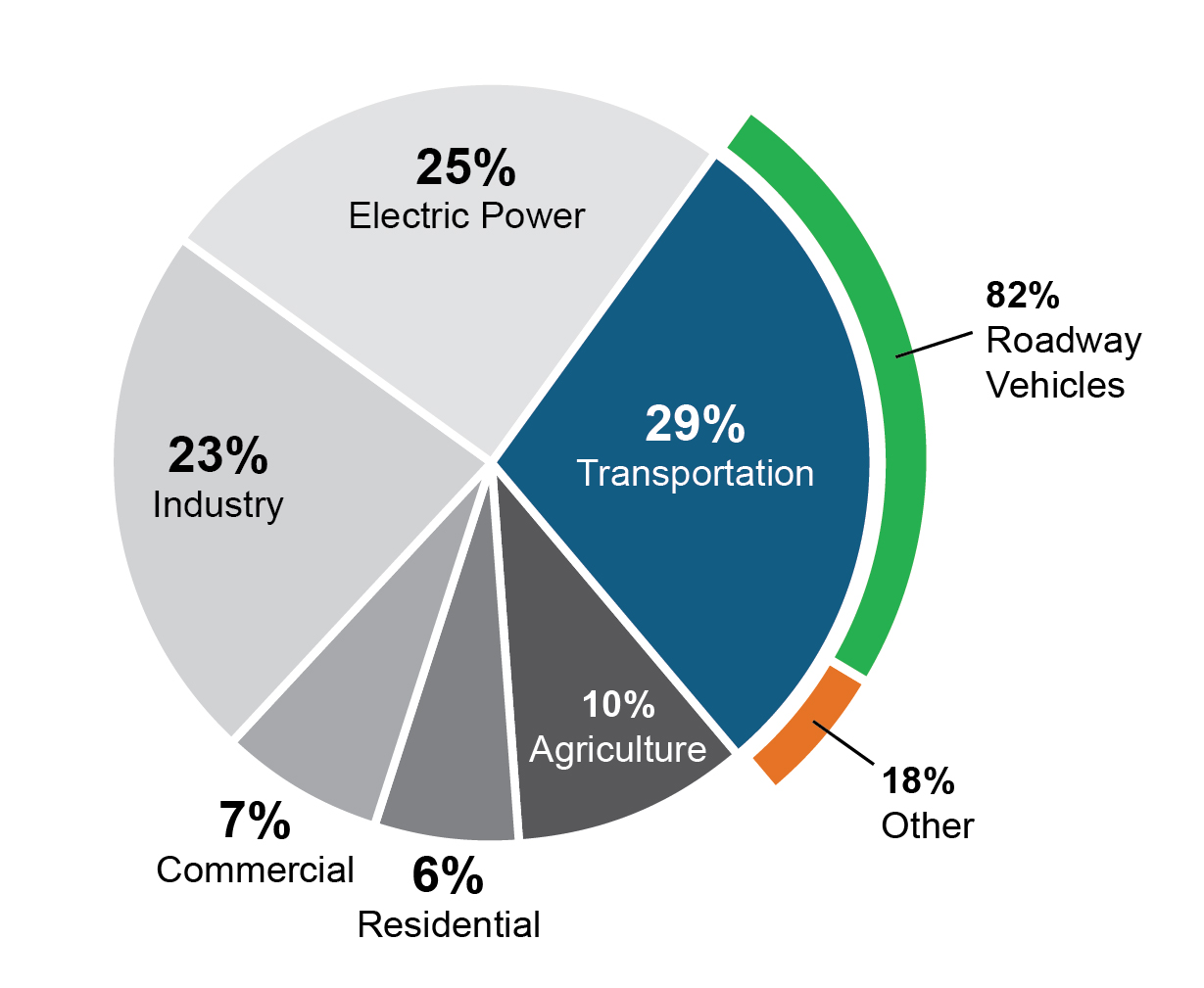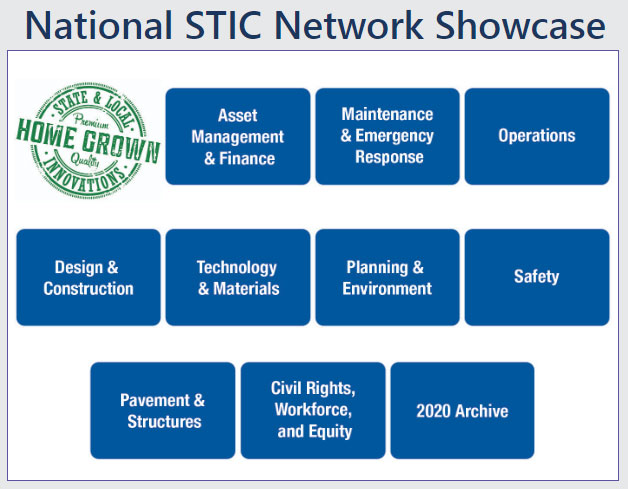July 13, 2023
Integrating GHG Assessment and Reduction Targets in Transportation Planning
Transportation is the largest emitter of greenhouse gas (GHG) emissions in the United States—as well as one of the fastest growing sources. National inventories suggest the transportation sector generates approximately 29 percent of our nation’s GHG emissions, and roadway vehicles account for about 82 percent of that amount.
State departments of transportation (DOTs) and metropolitan planning organizations (MPOs) play essential roles in implementing policies, programs, and projects that can reduce GHG emissions. These agencies influence the pipeline of projects that impact emissions not only directly from motor vehicle tailpipes, but also life-cycle emissions from construction and embodied carbon of materials. Life-cycle emissions represent carbon emissions released during the lifecycle of building materials, including mineral extraction, manufacturing, transportation, construction, and disposal. Establishing targets and including GHG emissions analysis in the transportation planning process is a critical step that agencies can take toward meeting national reduction goals and reducing their climate impact. Integrating the consideration of GHG emissions into agency procedures and decision-making can lead to better transportation program and project decisions.
Oregon is one State leading the way with work in this area. In 2020, a State executive order directed the Oregon Department of Transportation (ODOT) to develop and apply a process for evaluating GHG implications of transportation projects in the Oregon statewide transportation improvement plan (STIP). ODOT’s climate office developed an analysis process for multiple phases of STIP decision-making across the transportation system lifecycle, which carries out the direction of the State executive order.
The Oregon STIP looks at State-led and -administered projects for user emissions (from drivers), embodied emissions (generated during construction), and funding impacts (tracking expenditures on STIP projects that affected GHG emission reduction goals). Quantifying these emissions enables the Department to influence discretionary funding decisions early on, influence project selection, and establish benchmarks to measure progress towards its emissions goals. ODOT recognized that implementing GHG assessment earlier in the planning process made it more likely for those goals to be achievable. The Department focused on policy-level actions that would establish consistency and a framework for future success in emissions reductions. According to ODOT, the process resulted in more funding for active transportation priorities.
 Transportation accounts for 29 percent of GHG emissions, and 82 percent of that is from roadway vehicles. (Source: 2021 EPA GHG inventory report)
Transportation accounts for 29 percent of GHG emissions, and 82 percent of that is from roadway vehicles. (Source: 2021 EPA GHG inventory report)
To make the information more relatable to the public ODOT reports on the actions and behaviors that increase or decrease emissions in the portfolio of STIP projects in construction. In addition, Oregon’s Transportation Emissions website helps explain and track progress from state and local efforts, and market trends on the various actions that make up Oregon’s Transportation GHG reduction roadmap.
Subscribe to this innovation’s e-bulletin to stay up-to-date on the latest news. To learn more about Integrating GHG Assessment and Reduction Targets in Transportation Planning, please contact David D'Onofrio, FHWA Office of Natural Environment, or Jim Thorne, FHWA Office of Planning.
North Carolina Incorporates Crowdsourcing into Disaster Recovery
Over the years, major hurricanes have inundated North Carolina localities and roads with water. Recent storms, Matthew and Florence, closed 1,500 and 2,500 roads, respectively. When a major storm hits North Carolina, communicating which roads are passable and which are unsafe both during and after the storm is critical to the safety of road users and emergency response personnel. Many travelers rely on private navigation applications, so the collaboration between public agencies and navigation application companies is critical to ensuring that the quickly changing road conditions are accurately reflected on their platforms.
As a standard procedure, the North Carolina Department of Transportation (NCDOT) monitors roadway traffic conditions in advance of storms in case of evacuations from adjacent States. During the storm, the agency focuses on monitoring and sharing closure information with Waze, Google Maps, and Apple Maps. For example, Waze may show a bridge as closed and NCDOT may then update its system or deploy resources to clear a blocked road once verified. Conversely, NCDOT may transmit closed road information to Waze.
To better prepare for future hurricane seasons, NCDOT conducted a hurricane training exercise with the Waze Crisis team. For the training exercise, the agency created a mock storm that crossed the state and resulted in flash flooding. Technology that monitors the impacts of storm surge is hypothesized to cordon off a region as a “No Drive” zone during the training exercise. NCDOT defined and shared the mock road closure, shelter, and no drive zone data with Waze. Travelers approaching the no drive zone and using the Waze app would then receive notice that they are entering a no drive zone and to consider alternate routes.
The training exercise helped increase NCDOT operators’ familiarity with Waze tools and processes, increased their understanding of how to interact with the Waze Crisis Team, and improved readiness for and resiliency from a real storm emergency.
To learn more about NCDOT’s Waze Crisis training exercise, view the September 2022 Adventures in Crowdsourcing webinar recording. To learn more about how crowdsourcing can advance operations for your region, please contact one of the FHWA EDC-6 Crowdsourcing Co-leads: James Colyar, Greg Jones, or Ralph Volpe.
New Innovator Now Available!

The July/August issue of Innovator is now available, accessible from your computer, tablet, or mobile phone to optimize your reading experience!
In this issue:
- An Open-Ended Approach to Meeting Design-Build DBE Goals
- Capturing the Value Created by Transportation
- Missouri Accelerates Market Readiness for Work Zone Innovations
- Innovation and Impact
- And more...
Comments? Questions? We'd love your feedback! Drop us a line and let us know what you think.
Read past issues and sign up to receive Innovator by email here, or text "FHWA Innovation" to 468311 to get Innovator on your smartphone.
Discover Home-Grown Innovations from Around the Country

Are you interested in homegrown innovations being used by your peers in other parts of the country? Check out the National STIC Network Showcase, a component of the EDC-7 Virtual Summit. Registering for the event allows you to access all the content through February 2024.

Learn about the Ohio Department of Transportation's (ODOT's) bridge upcycling program, which takes and reuses steel beams left over from bridges that are demolished or rehabilitated. This program helps stretch financial resources and reduce the amount of new steel required for projects.
Celebrate the ingenuity of your peers and read about these innovations—developed and deployed in-house at transportation agencies nationwide. Additionally, we invite you to watch the one-hour presentations on-demand that feature many of these and other innovations.
Stay Up to Date on the EDC Innovations That Interest You Most

EDC teams are always on the move! If you blink, you could miss out on important webinars, case studies, tools, videos, and more. To never miss information for the EDC innovations that interest you most, visit the subscription page and select the topics you’d like to receive updates on directly from the teams that coordinate them.
Recent bulletins:
Innovation in Project Delivery 7/3/2023
About EDC
Every Day Counts, a state-based initiative of the Federal Highway Administration's Center for Accelerating Innovation, works with state, local and private sector partners to encourage the adoption of proven technologies and innovations to shorten and enhance project delivery.
EDC News is published weekly by the FHWA Center for Accelerating Innovation.
Notice: The U.S. Government does not endorse products or manufacturers. Trademarks or manufacturers‘ names appear in this presentation only because they are considered essential to the objective of the presentation. They are included for informational purposes only and are not intended to reflect a preference, approval, or endorsement of any one product or entity.
Recommended Citation:
U.S. Department of Transportation, Federal Highway Administration
EDC News; July 13, 2023
Washington, DC
https://doi.org/10.21949/1521755


